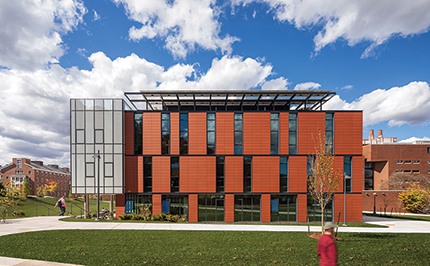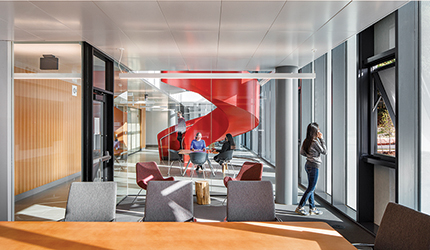
Leers Weinzapfel Associates designed the completed 32,995 s/f Anonymous Hall at Dartmouth College

Hanover, NH Leers Weinzapfel Associates designed the newly completed Anonymous Hall at Dartmouth College. Named for alumni and friends who have quietly supported the college over two centuries, the $28 million project reuses and adds to vacant 1960s library in the siloed north campus quad, transforming it into an administrative and social center for the Graduate School of Arts and Sciences and a communal hub for the area. Part of a wider campus renewal plan, metrics show the project is close to net zero energy use.
Windover Construction provided preconstruction and construction management services for the project.
Centrally located among 1960s medical school buildings, the 32,995 s/f project, which also includes new entrances for surrounding structures, a wide pedestrian bridge, and new circulation between buildings—transforms an isolated edge of the college into a well-scaled, inviting North Quad. The initiative generates an accessible, seamless link between north campus and the historic green and main campus, allowing it to be shared with undergraduate sciences.

The demolition of an unused laboratory adjacent to the former Dana Hall made way for an addition, which reorients the building to create inviting campus connections to the south. Now the new social center of north campus, the addition houses the lobby and a café with an adjacent terrace overlooking a green. Tied together by a spiral object stair visible from the south lawn, the building’s upper floors contain collegial faculty offices, classrooms, and places for interactive student gathering. The rooftop level features a solar paneled canopy and a south-facing planted terrace that overlooks the Vermont hills, Baker Tower, and the iconic main campus. The walk-out graduate student lounge in the lower level opens to a protected courtyard below a pedestrian bridge.
The building was stripped to its columns and slabs to remove hazardous materials in the existing library walls before construction could begin. As a reused concrete structure in a cold climate, the choices of highly insulated terra-cotta-clad walls, triple glazed windows, and a photovoltaic canopy created a building with low embodied energy that approaches net zero energy usage. The facade system is first-of-its-kind in the US, comprising multiple advanced technologies including vacuum insulated, panels, krypton filled triple glazing, metal mesh integral shading, and toggle-held structural glazing (2 IGUs).